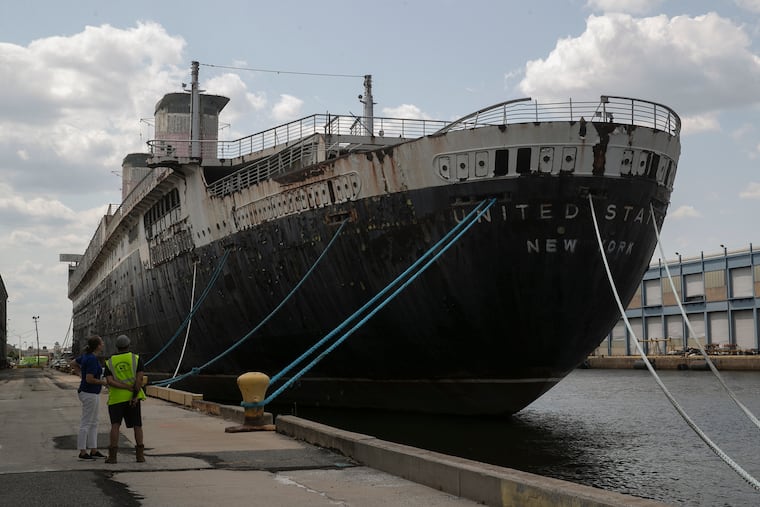SS United States is ‘every landlord’s nightmare,’ pier’s lawyer says as rent dispute goes to trial
SS United States conservancy said it was never its plan to leave the ship at Pier 82 indefinitely.

The SS United States, once known as the “Queen of the Seas” and better known today as the “Ikea boat,” faced its landlord in court Wednesday, the culmination of a yearslong rent dispute.
Still, by the end of the daylong testimony, U.S. District Judge Anita B. Brody made a suggestion ahead of what’s expected to be the final day of the bench trial Thursday.
“I think you may have to settle,” said Brody, warning that if she had to decide whether the SS United States gets evicted from its berth or continues to pay according to the terms of an agreement signed in 2011, there would be only losers in the case.
The nonprofit caring for the ship, the SS United States Conservancy, has been in a prolonged rent dispute with its landlord Penn Warehousing, which leases Pier 82 along Christopher Columbus Boulevard. In August 2021, Penn Warehousing doubled rent from an $850 daily dockage fee to $1,700, but the conservancy continued to pay the original rate stated in the 2011 berthing agreement. In response, Penn Warehousing terminated the lease in March 2022.
Penn Warehousing’s attorney Craig Mills described the conservancy as having been an unproblematic tenant for a decade. But that suddenly changed when Penn Warehousing asked the conservancy to change how it secured the ship to avoid damaging the pier and bollards. It refused to pay rent and refused to leave even after Penn Warehousing, citing back rent, voided the lease.
“They were every landlord’s nightmare,” Mills said.
Penn Warehousing’s legal team told Brody the conservancy owes $730,000 in back rent and asked the judge to order the tenant to pay their past-due bill, repair bollards, and leave the pier.
The conservancy’s attorneys focused their case on the language of the berthing agreement, which laid out the daily dockage fee at $850 “continuing until upon removal of the vessel from its current location.”
At the heart of the case is the question of whether the 2011 agreement is a lease in perpetuity and under what circumstances Penn Warehousing can terminate its lease.
John Mitchell, part of the conservancy’s legal team, argued Penn Warehousing doubled the rent without discussing it with the conservancy and that there’s no mechanism in the agreement to raise rent unilaterally. He pointed to the notice the ship’s landlord sent at the time of the increase, which only made mention of rising costs, not all the claims of the SS United States causing damage to the pier.
The conservancy’s legal team asked the judge to enforce the berthing agreement, saying the ship could be headed to the scrapyard otherwise.
“They want to seal the fate of what’s an American icon,” said Mitchell.
The latest obstacle for the SS United States
Christened in 1952 and at the time considered a feat of American engineering, the vessel was once visited by future presidents, royalty, and celebrities, including Marilyn Monroe. The vessel broke the record for the fastest Atlantic crossing and could transform into a military vessel capable of carrying thousands of troops. Its historical significance earned the ship a place on the National Register of Historic Places.
But as flying became a much more efficient way to cross the Atlantic, the SS United States’ popularity declined. The vessel was retired in 1969, going into U.S. Navy control and serving as a reserve ship until 1978, when it was put up for sale.
The ship would go on to change ownership several times as investors imagined redevelopment plans, including time-share condos and a cruise line, that would time and time again prove to be too expensive or poorly timed.
Just as its then-owner Norwegian Cruise Line was ready to sell the ship for scrap in 2010, philanthropist H.F. “Gerry” Lenfest — the late former owner of The Inquirer and whose Lenfest Institute now owns the paper — stepped in. He pledged $5.8 million to the cause, allowing the conservancy to buy the ocean liner. But the relief was short-lived. The conservancy was once again sending an SOS in 2015 to avoid the scrapyard. The following year, the possibility of making the ocean liner functional again was ruled out.
“All of its potential partners walked away,” said Mills in court.
He argued the berthing agreement was worded how it was because “nobody knew when the ship would leave Pier 82.”
During testimony, Susan Gibbs, president of the conservancy and granddaughter of the vessel’s designer, was asked if she expected the ship to remain at Pier 82 a decade after signing the berthing agreement.
She said it was a difficult question to answer, in part, because she never expected so many donors from around the globe to make financial contributions over the years. She said it’s hard to say just how long the conservancy will be able to continue to pay for the ship’s rent and other expenses, but it was never the plan to keep the vessel at Pier 82 indefinitely.
Still, Gibbs insisted the conservancy has a viable redevelopment plan, released in January, but just needs more time to find a partner.